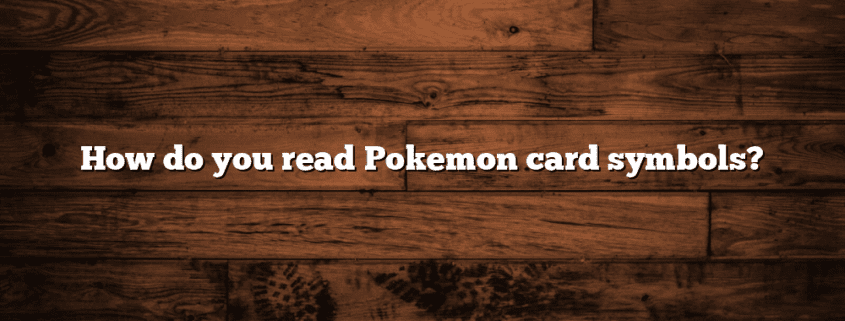How do you read Pokemon card symbols?
How to Read Pokemon Card Symbols: A Comprehensive Guide
Pokemon cards have been a beloved collectible for fans of all ages since their introduction in 1996. With their vibrant artwork and strategic gameplay, these cards have captured the hearts of millions around the world. However, for newcomers to the Pokemon Trading Card Game (TCG), understanding the symbols on the cards can be quite daunting. In this article, we will provide a comprehensive guide on how to read Pokemon card symbols, empowering you to navigate the world of Pokemon TCG with confidence.
1. Card Types
Pokemon cards are categorized into different types, each representing a specific element or characteristic. These types include:
- Grass
- Fire
- Water
- Lightning
- Psychic
- Fighting
- Darkness
- Metal
- Fairy
- Dragon
- Colorless
The type symbol is located in the upper right corner of the card and is represented by a unique icon corresponding to the type. Understanding the type of a Pokemon card is crucial for building a well-balanced deck and strategizing during battles.
2. Energy Symbols
Energy symbols on Pokemon cards indicate the type and amount of energy required to use a particular attack. These symbols are found on the top right of the card, just below the card type symbol. Each energy symbol represents a specific type of energy, such as Grass, Fire, Water, etc.
For example, if a Pokemon card has a Grass energy symbol, it means that one Grass energy card is required to use an attack associated with that Pokemon. Some attacks may require multiple energy symbols of the same type or a combination of different types.
3. Evolution Symbols
Evolution symbols on Pokemon cards indicate the stage of evolution a Pokemon is in. These symbols are located on the top left of the card, just below the card name. There are three types of evolution symbols:
- Basic: A solid black circle represents a basic Pokemon, which is the initial form of a Pokemon.
- Stage 1: A black circle with an arrow pointing to the right indicates the first stage of evolution.
- Stage 2: A black circle with two arrows pointing to the right represents the final stage of evolution.
Understanding the evolution symbols is essential for knowing when and how to evolve your Pokemon during a battle.
4. Rarity Symbols
Rarity symbols on Pokemon cards indicate the rarity or scarcity of a particular card. These symbols are located on the bottom right of the card, just above the card number. The rarity symbols include:
- Circle: Common cards, which are the most common and easiest to find.
- Diamond: Uncommon cards, which are less common than common cards.
- Star: Rare cards, which are harder to find and often more valuable.
- Star Holofoil: Rare Holo cards, which have a holographic foil pattern and are highly sought after by collectors.
- Star Holofoil with Shiny Background: Ultra Rare cards, which are extremely rare and highly valuable.
Understanding the rarity symbols can help you determine the value and desirability of a Pokemon card.
5. Ability and Special Symbols
Some Pokemon cards may feature additional symbols to indicate special abilities or effects. These symbols can vary depending on the card and its specific abilities. It’s important to read the card’s text and instructions to understand the significance of these symbols.
Summary
Reading Pokemon card symbols may seem overwhelming at first, but with a little practice and understanding, you’ll be able to decipher the information they convey. By familiarizing yourself with the card types, energy symbols, evolution symbols, rarity symbols, and any special symbols, you’ll gain a deeper appreciation for the strategic gameplay of the Pokemon TCG.
Remember, the symbols on Pokemon cards are not just decorative elements; they hold valuable information that can enhance your gameplay and collection. So, dive into the world of Pokemon TCG, armed with the knowledge of how to read these symbols, and embark on an exciting journey to become a Pokemon Master!




Leave a Reply
Want to join the discussion?Feel free to contribute!